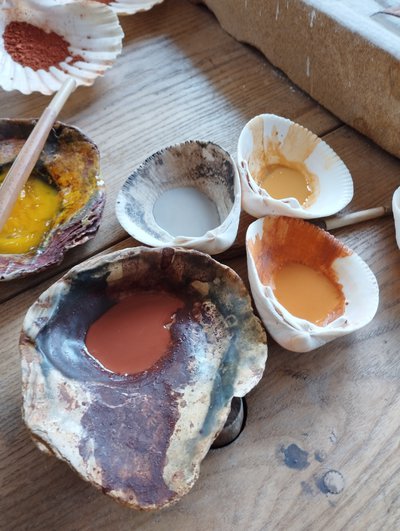- Home
- Skills Training
- Courses
- Making Natural Paints, Pigments and Limewash Workshop
This course explores the tools and techniques used many thousands of years ago
Day workshop:
In this workshop you will discover how many ancient / traditional / historical paints were made (and still are) and where to start to make your very own natural paints and mineral pigments at home.
A perfect starting point to create your own simple, efficient, sustainable, plastic-free art materials and/or to beginning a journey into making your own interior paints... Or to scratch that itch and understand where these extra pigments we use in construction and conservation actually come from!
We will start the day with the base principles of pigment-making: extracting pure colours from various minerals, from local earths to sands and clays foraged by the tutor. These natural pigments can be used not only for paints, but for making pastels, crayons, mortar additives… even cosmetics!
(Pigments samples can be taken home to finish or use after the course)
Then we will explore different binders (adhesives to mix with pigments to make paint) and testing the paints made. We will focus on three paints:
(With one batch with chalk powder and another with limewater / lime putty -Works on many surfaces.)
- Tempera (egg yolk) (For details and small designs on many surfaces.)
- Scandinavian "Falu red" / flour paint (For wooden surfaces, both inside and outside.)
The afternoon will be spent making, pigmenting and applying limewash, and we will look at:
- Suitable substrates for lime washing
- Substrate preparation
- Making lime washes:
- ‘Simple’ limewash for inside or out – lime putty and water
- ‘Refined’ limewash for inside – sieved through nylon muslin (to remove overburnt/under burnt particles of limestone)
- Pigmenting limewash with alkali resistant earth pigments – for small and large scale works
- Copperas limewash using iron sulphate crystals to colour limewash (exterior only)
- Tallow limewash – incorporating refined animal fat into a ‘hot mix’ of quicklime and water (slaking to generate heat to melt animal fat) – also for exterior works only
- Application techniques
- Curing, protection and aftercare procedures
There will be time for questions after the demonstration, then if time allows, there will be extra paints-tests, and/or a micro demonstration of roasting pigments to create more shades.
Participants are very welcome to enquire about other types of paints and their suitability for various surfaces or projects, bring examples of their work or even bring a small sample of their own soil, sand or mineral to check if it can be turned into pigment. Chats and questions are strongly encouraged!
Notes:
. Do not hesitate to bring your own notebook, thermos/coffee cup and an apron if you fancy wearing one (pigments CAN stain clothes).
. Tea breaks and lunch will be spread throughout the day.
Limited spaces available
Please note: Course fees are payable upon booking and are non refundable.
About the Tutors:
Caroline Nicolay (who runs ‘’Pario Gallico’’) is an archaeologist and heritage interpreter specialising in bringing historic techniques and crafts to life, from paint making in early history to open-fire cooking using clay pots. Her research was focusing on Iron Age wall paintings and evolved towards historic and vernacular building techniques.
Mainly working with museums and heritage sites, she has been running courses for a number of years, hoping to share widely some techniques that are both thousands of years old and increasingly popular in our 21st century as sustainable arts & building practices.
Roz Artis is a RICS Certified Historic Building Professional. Her career with the Scottish Lime Centre Trust (SLCT) has focused on the appropriate repair and care of traditional buildings, particularly the reinstatement of external lime finishes.
She has written several publications on the practical use of lime and other mortars including Natural Stone Masonry in Modern Scottish Construction – A guide for designers and constructors, various articles for the BLF Annual Journal and the Building Conservation Directory.
Roz also writes all the learning resources for the wide ranging course programme offered by the SLCT and is one of the primary tutors and heads the very busy building advisory service it offers, dealing with castles to cottages and masonry arch bridges to lighthouses, and everything in between. Just five minutes with Roz ensures you will view traditional stone and lime walls in a very different way... she even does it on holiday!
Cost
£172.52 + VAT
(£207.02 incl VAT)
Starting on: Sept. 19, 2025:
